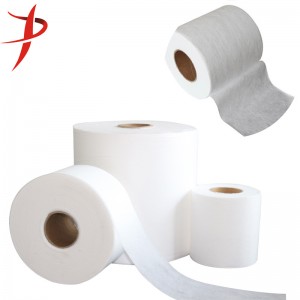At present, meltblown nonwoven fabrics are widely used in the field of filtration materials.Since the 1970s, a variety of charging technologies and unique filters with electrostatic charges by mixing different fibers have been developed and utilized.The immediate result is the current electrostatic electret process.At present, electret methods mainly include electrostatic spinning, corona charging, friction electrification, thermal polarization, low-energy electron beam bombardment, pure water jet, etc. Due to different electrostatic electret processes of materials, the properties of electret bodies formed are also very different, and there are differences in the improvement of filtration performance and electrostatic persistence.
In fact, the filtration performance of meltblown nonwoven fabrics is only less than 70%, and it is not enough to rely solely on the mechanical blocking effect of the three-dimensional aggregation of ultrafine fibers with fine fibers, small voids and high porosity.Otherwise, simply increasing the material gram weight thickness will greatly increase the filtration resistance.Therefore, melting and spraying filter materials generally add electrostatic charge effect to melting and spraying cloth through electrostatic electoral-electrode process, and use electrostatic method to improve filtration efficiency, which can reach % to %.That is to meet the KN95 standard or above.
Electret air filter material USES the polarity of the fiber itself to adsorb dust electrostatic and capture bacteria and viruses.The electric charge of the electret of polypropylene fused jet fiber is different from that of the friction belt of ordinary materials.It is not scientific to draw paper fragments to judge whether molten spray is charged or whether the mask has filtration performance by means of friction electrification.Friction electrification is a temporary charge, is the surface charge is temporarily gathered phenomenon.Friction charge is the positive and negative surface polarized charge, while electret fiber charge is the extra internal charge added by applying high voltage charge during electret process.These charges are dispersed in the porous interior of the molten ultrafine fiber in the form of electret master nanoparticles.The water resistance of the molten jet material and the barrier of the ultrafine fiber make these charges firmly locked in the interior. When only the fine particles enter the interior of the molten jet layer, the electrostatic effect and the structure of the ultrafine fiber begin to play a role.
The so-called static electricity is because the polypropylene molten jet material itself is insulating, is also a kind of electpoles material, so the charge will not be randomly neutralized, randomly dissipated.The extra high voltage discharge charge is stored in the fiber for a long time with sufficient electric charge. Moreover, it is the co-existence of multiple charges, not a kind of charge generated by friction. Therefore, macro adsorption cannot directly reflect the microscopic charge performance.The high porosity and open electrostatic electret properties of ultrafine fibers are used to provide high efficiency and low resistance filtration quality.In extremely antibacterial mechanism of action is electret melt-blown cloth stimulate a strong electrostatic field and microelectronics flow of bacteria, make its protein and nucleic acid mutation damage, destroy the bacteria of surface structure, killing bacteria, release negative ions tourmaline itself blocked some bacteria microbial metabolic processes, including the respiratory system, the activity of the enzyme, mass transfer from the cell wall, thus inhibiting bacterial cells have antibacterial effect.
We are a meltblown nonwoven fabric manufacturer, welcome to consult us ~
Post time: Jul-30-2020

